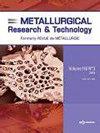The central deformation calculation and analysis of the heavy steel plate for the gradient temperature rolling
IF 1.1
4区 材料科学
Q3 METALLURGY & METALLURGICAL ENGINEERING
引用次数: 1
Abstract
The traditional symmetrical rolling process may result in the insufficient central deformation of the heavy steel plate. The gradient temperature rolling (GTR) based on the ultra-fast cooling was adopted in order to improve the central deformation and keep the deformation along the thickness to be well distributed. The temperature and strain field of the gradient temperature rolling were obtained by the thermo-mechanical coupling finite element method combined with different surface heat transfer coefficient, plate thickness, work roll diameters and so on. The calculated results showed that the deformation was more likely to penetrate into the core compared with uniform temperature rolling (UTR). The central equivalent strain with GTR was increased by 44.3% maximum compared with UTR in the same case. The deformation along the thickness was well distributed compared to the UTR. The central deformation gradually increases with the increase of reduction rate, surface heat transfer coefficient, work roll diameters and speed ratio, while the central deformation almost unchanged with linear velocity. Furthermore, industrial application showed the deformation can penetrate into the core compared with the UTR and it can help to eliminate the band structure. In this study, the influencing law of equivalent strain along the thickness with different parameters was summarized. The fitting model to calculate the central equivalent strain after GTR was established according to the numerical results. It can provide reliable theory and technology support for the setting of various parameters for GTR.梯度温度轧制厚钢板的中心变形计算与分析
传统的对称轧制工艺可能导致厚钢板中心变形不足。采用基于超快冷却的梯度温度轧制(GTR)来改善中心变形,并保持变形沿厚度的均匀分布。结合不同表面换热系数、板厚、工作辊直径等因素,采用热力耦合有限元法得到了梯度温度轧制的温度场和应变场。计算结果表明,与均温轧制相比,变形更容易渗入芯内。与UTR相比,GTR的中心等效菌株在相同情况下最大增加44.3%。与UTR相比,沿厚度方向的变形分布较好。随着压下率、表面换热系数、工作辊直径和速比的增大,中心变形逐渐增大,而随着线速度的增大,中心变形基本不变。此外,工业应用表明,与UTR相比,变形可以渗透到核心,有助于消除带状结构。本文总结了不同参数下等效应变沿厚度方向的影响规律。根据数值结果,建立了计算GTR后中心等效应变的拟合模型。为GTR各参数的设置提供可靠的理论和技术支持。
本文章由计算机程序翻译,如有差异,请以英文原文为准。
求助全文
约1分钟内获得全文
求助全文
来源期刊

Metallurgical Research & Technology
METALLURGY & METALLURGICAL ENGINEERING-
CiteScore
1.70
自引率
9.10%
发文量
65
审稿时长
4.4 months
期刊介绍:
Metallurgical Research and Technology (MRT) is a peer-reviewed bi-monthly journal publishing original high-quality research papers in areas ranging from process metallurgy to metal product properties and applications of ferrous and non-ferrous metals and alloys, including light-metals. It covers also the materials involved in the metal processing as ores, refractories and slags.
The journal is listed in the citation index Web of Science and has an Impact Factor.
It is highly concerned by the technological innovation as a support of the metallurgical industry at a time when it has to tackle severe challenges like energy, raw materials, sustainability, environment... Strengthening and enhancing the dialogue between science and industry is at the heart of the scope of MRT. This is why it welcomes manuscripts focusing on industrial practice, as well as basic metallurgical knowledge or review articles.
 求助内容:
求助内容: 应助结果提醒方式:
应助结果提醒方式:


